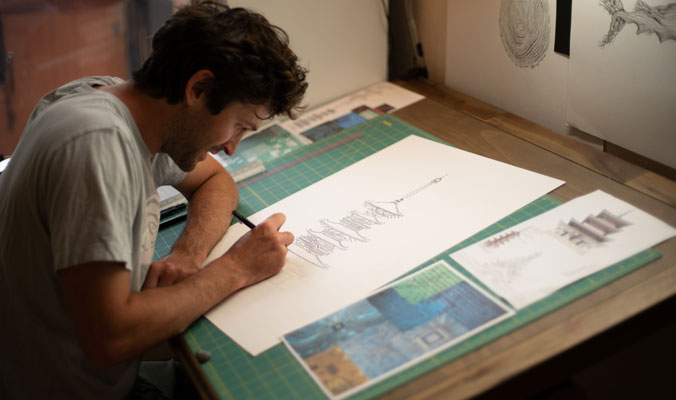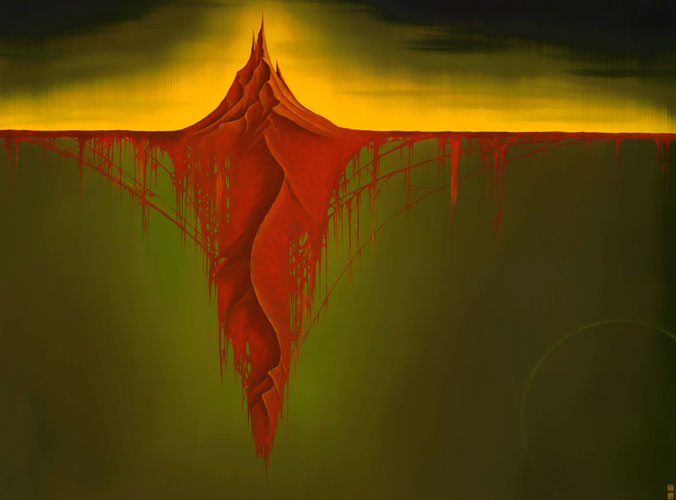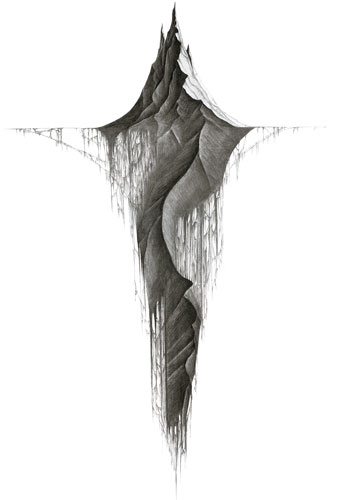Freeskier Eric Pollard has spent nearly two decades working within in the ski industry, from crafting skis with LINE to starting the film company Nimbus Independent—all while creating illustrations and paintings that capture these experiences. He balances his time between these passions, but he’s mindful of frequently taking note of sights and inspirations that can inform his creativity throughout his busy schedule. In this installment of Skintrack Sketches, we caught up with Pollard to discuss how he finds time to be an artist and where he derives his constant drive to find meaning through the artistic process.

Backcountry Magazine: When did you first start to draw and paint?
Eric Pollard: I liked art from a young age. I sketched a lot during elementary and middle school, but in high school I started to draw things that drew people’s notice. From those reactions, I gained enough confidence to pursue drawing and other art forms and to take a deeper dive into more art forms. At first, I painted mostly wall art, but then I started to explore oils, acrylics, watercolors and airbrush. I wasn’t especially talented in technical drawing skills and I don’t have any educational background in art.
BCM: What does your artistic process look like?
EP: It’s pretty simple; I ski around the world and isolate a physical figure that I think is beautiful and extract it from its environment. The first things I would recreate were almost always trees, but since then, what I isolate has evolved, but I still marvel at shape.

BCM: You have a lot of projects going on from film to product design, painting and skiing. How do you manage it all?
EP: My life goes through these seasons; it’s this cycle of managing it all and trying to figure out how much I can take on and how much time I actually have. It’s like shifting though the gears—I get hyper-focused. I’ll do heavy doses of one project where I’ll dive into something for a month and work through it, solve problems and get to a certain point. But there’s overlap in everything I do. I’m constantly filming and editing, and then I set aside time to work on a ski or a pair of snow pants or a graphic for a period certain of time.
There are times when I paint and my work never sees the light of day. These works aren’t very good. Generally speaking, you can’t paint for a limited block of time and expect your technique to be good and for it to progress. In my case, I have to acclimate each time I start a work of art and figure out where I can push myself and figure out if I have any new ideas and how to execute them. Sometimes I dive in and paint for three weeks, and what comes from it is usually a journey where some of the products can be pretty embarrassing. I’m trying to execute a vision in my head and typically I don’t hit it out of the ballpark. Even after a lot of work I might scrap a whole painting and start again, because I learned the technique while I was creating.

BCM: What does your art mean to you?
EP: I get a lot of satisfaction out of the process. When you get older, you start to recognize how much impact a practice can have on your life and how it gives you peace of mind. Skiing has always been that for me, now more so than ever. Art to me is an expression of this experience. It’s one of those things where, once you build enough technique and master enough of the tools, you can really express yourself. Art to me, more than anything, is a practice just like skiing or filming; it’s something that I work at to express what comes out of me. A lot of the time, I don’t have a strong feeling of what the final product is, but I like the journey. It is much more about creating, focusing on something, collaboration and mastering the expression.

BCM: What is the message behind the works you’ve created?
EP: Some works are about what’s under the surface, the unseen underneath natural elements and people. It’s all about the reduction of a concept; it’s the most challenging thing to do and a lot of my art is the bottling of something larger. I want to show the hidden connections between what I see and create, then have a person ask what that unseen means for them: “How does my community and where I come from shape who I am? How does the context create the content of who I am?”
I pull from my journey and what I see works itself into a number of outlets whether it’s graphics or film. It’s the way I see the world and it comes out in different ways and they’re all connected through my experience.
—
Eric Pollard currently lives with his wife and two daughters in Oregon where he is continuing to design ski and apparel, film and edit for Nimbus Independent and create art for his partners and his gallery. For more information and inquires, visit ericpollarddesign.com.










Related posts:
Skintrack Sketches: Artist and designer Joseph Toney takes an abstract view of the skintrack
Skintrack Sketches: Swiss artist Corinne Weidmann explores layers in the landscape
Skintrack Sketches: Skiing, art and loss through the eyes of Sandra Fransson
Skintrack Sketches: Vermont artist Jess Graham speaks to her love of lines in painting and snowboard…